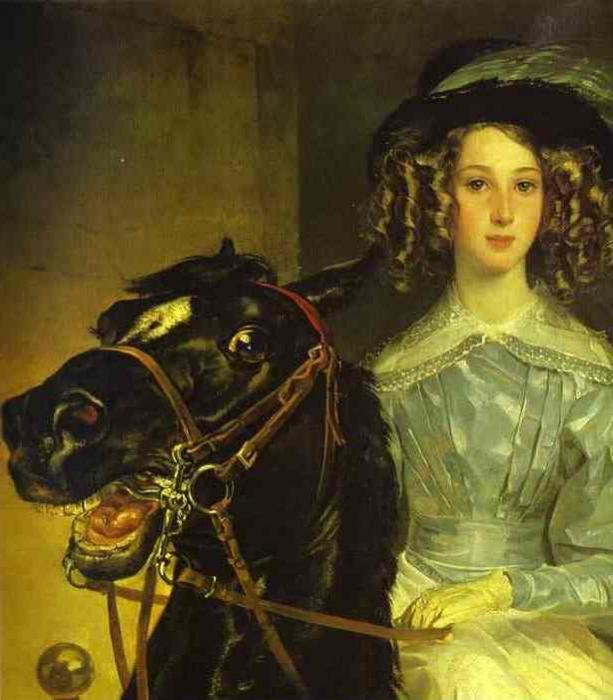In 1832, traveling in Italy, K. Bryullov took an order from the Russian Countess Yu. P. Samoilova to paint a picture depicting her two Italian pupils - the small four-year-old Amacilia and the young beauty Giovannina. The order has been completed. Now this painting, entitled “The Horsewoman,” adorns the hall of the Tretyakov Gallery. Looking at the canvas, we can confidently say that the artist worked with great enthusiasm and drew amazing beauty that embodied the deep ideas of romanticism of the early 19th century, a work of painting.
The painting is considered one of the most striking and characteristic masterpieces that Bryullov created. The "Horsewoman" stands out, first of all, by the unusualness of the
artistic image, the picturesque plan. The portrayal of a fragile, graceful girl who easily manages a jerky horse causes genuine admiration not only for the little sister watching her from the
porch of a house or arbor, but also for the viewer looking at the canvas from another, real, world.
To draw an unusual portrait of a girl in full growth, riding a horse - this is the task that Bryullov set himself. The “Horsewoman” is depicted not in statics, but in motion, at that moment when she gracefully stops the black horse, heated by a walk and excited by the foreboding of the thunderstorm in the atmosphere. This foreboding is transmitted through light and shadow, through branches of trees inclined by gusts of wind, the sky, covered by clouds. The light falling on the fragile figures of people clearly distinguishes them from the darkened nature, the subtle nuances of which were portrayed by Bryullov. The horsewoman, however, is very calm and serene. It seems that the surrounding atmosphere only increases its joy from the feeling of fullness of life.
This amazing canvas is very decorative, it attracts the eye with subtle colors, with many subtle halftones of color and light that Karl Bryullov displayed on it. The “Horsewoman” is distinguished by a harmonious combination of truthfulness, realistic images with a deep symbolism of romanticism. This is emphasized by the unusual composition, the contrast of the image (after all, an equestrian portrait is more suitable for the commander or emperor, and not for a young girl).

Many art historians note some static face of the Amazon, but here lies the deep meaning that Bryullov put into this image. The horsewoman, her fragile figure, the way she manages the horse, even the hat with a flying veil, are the embodiment of earthly beauty and strength from a feeling of fullness of life and youth, therefore, she is indifferent to the tension prevailing in nature. This beauty is emphasized by the light enveloping the girl and distinguishing her against a dark background, as well as the enthusiastic and slightly envious look of the little girl watching her. In a vivid artistic image, one of the main ideas of Russian romanticism is conveyed - the grandeur and beauty of an earthly man who defies the elements.
The overall impression of the picture is amazing. The skill with which the Russian artist Bryullov performed is amazing. "The Horsewoman" is a picture that is undoubtedly one of the true adornments of the most complete and diverse collection of paintings by Russian artists in the State Tretyakov Gallery and a real "pearl" of the Romanticism era.